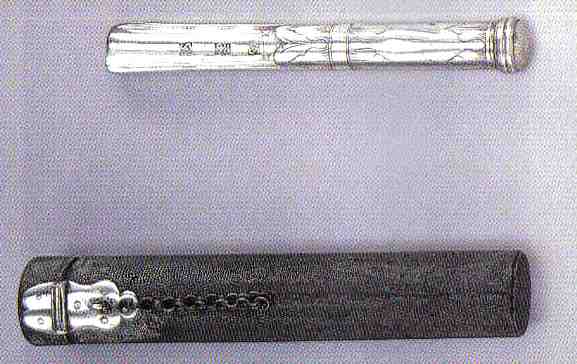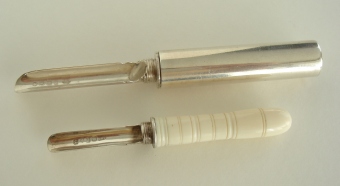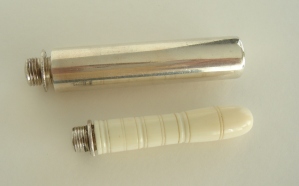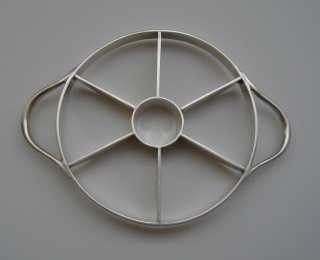 ASSOCIATION OF SMALL COLLECTORS OF ANTIQUE SILVER
ASSOCIATION OF SMALL COLLECTORS OF ANTIQUE SILVERASCAS
| article # 78 |
|
next |
previous |
(click on photos to enlarge image)EATING APPLES, THE ELEGANT WAYThe oldest extant apple corer dates to 1682. It is pictured in Michael Clayton's Dictionary (note 2) and was just recently sold as part of the James Walker collection (note 3). It features stiff leaf engraving where the blade meets the handle. The handle is equipped with a detachable caster at the end. Another late 17th century apple corer, probably Irish, features the same leaf decoration on the cylindrical shaft. It still comes with its contemporary shagreen case (note 4). A few eighteenth century examples have surfaced. There is an apple corer made by Maurice Fitzgerald, dating to ca. 1760-1800 in the Limerick City Museum (note 5). Notable is an apple corer engraved with royal arms, having belonged to one of the daughters of George III (note 6). Both examples are devoid of decoration and feature applied moldings on the cylindrical shaft. But there are not enough examples known to make meaningful remarks about a style change from seventeenth to the eighteenth century. The majority of silver apple corers date to the nineteenth and beginning of twentieth century. Utilitarian in form, their handles are silver cylinders, but also often wood or ivory - the latter frequently stained green.
Some of the apple corers are so small and of rather thin gauge that they were likely used for removing foul parts of the apple than coring it. An often seen variation is the "traveling" apple corer; the blade unscrews and fits neatly into the handle. This design seems much more practical for slipping into a pocket when going to the orchard or taking it along on a picnic. An even more useful design is the apple corer with integral knife. Another example of similar design but with an ivory handle, fitted with the knife and the blade on opposite ends was sold in the James Walker sale (note 7). Georgian, Victorian and Edwardian apple corers are marked on the blade - mostly on the inside - with a full set of marks. Examples hallmarked with only maker's mark, tax mark and lion passant are acceptable. The silver handles are mostly stamped with a lion passant only. By far the most extant apple corers were made by Joseph Willmore, Birmingham, but examples from all the other "toy" makers such as S. Pemberton, J. Taylor, etc. are found. In London the firm of Phipps and Robinson seemed to specialize in small kitchenware items, as many kitchen nutmeg graters etc. are found with this mark. American apple corers are even rarer. One known example, ca. 1820, was made by Thomas Charles Fletcher, Philadelphia - it is somewhat sturdier in design than English examples with a broader sheath and equipped with an ivory handle. (note 8). Christie's New York offered an apple corer in their January 16, 2003 sale. It was made by Thomas Hammersley of New York and dated to ca. 1760, but stayed unsold. (note 9).
ENDNOTES:
|
Dorothea Burstyn
|










